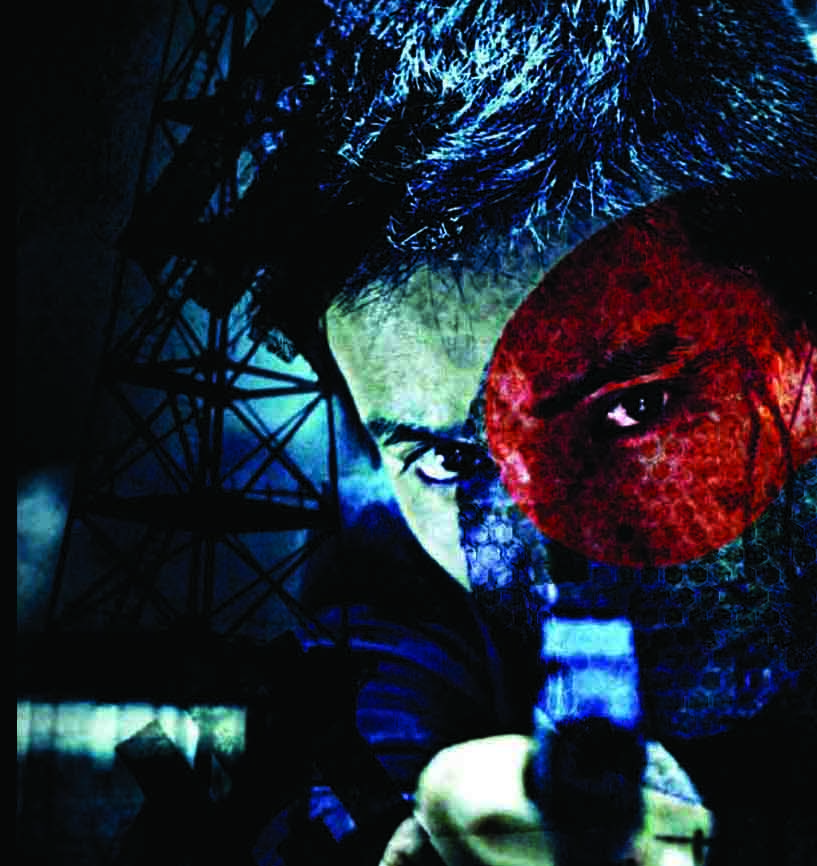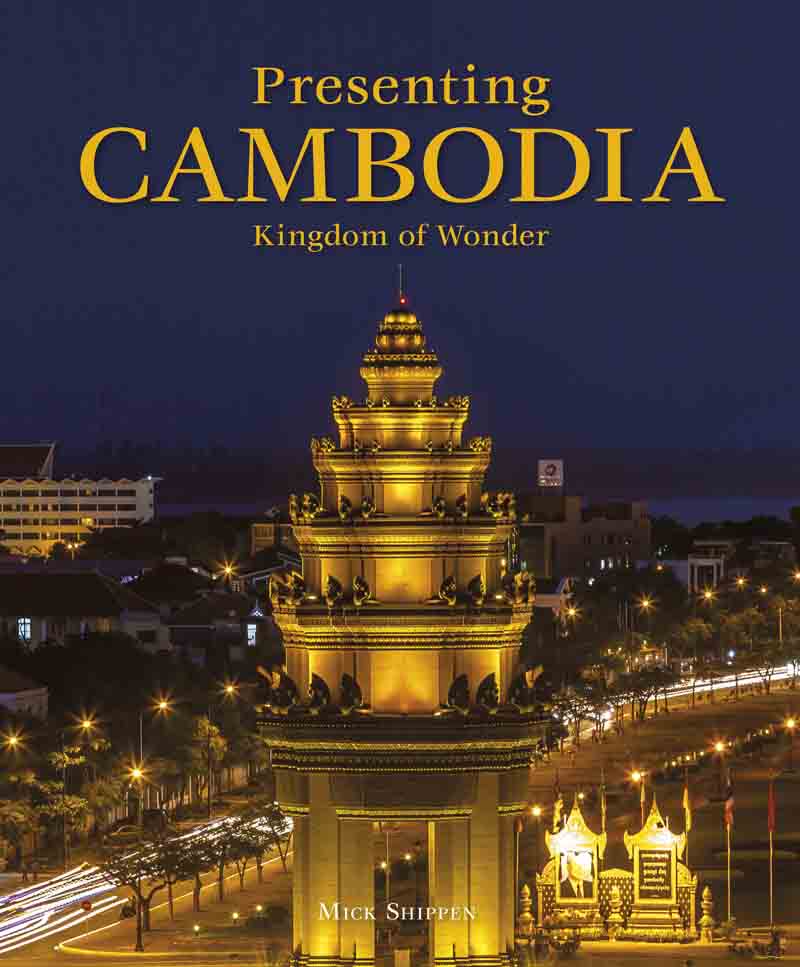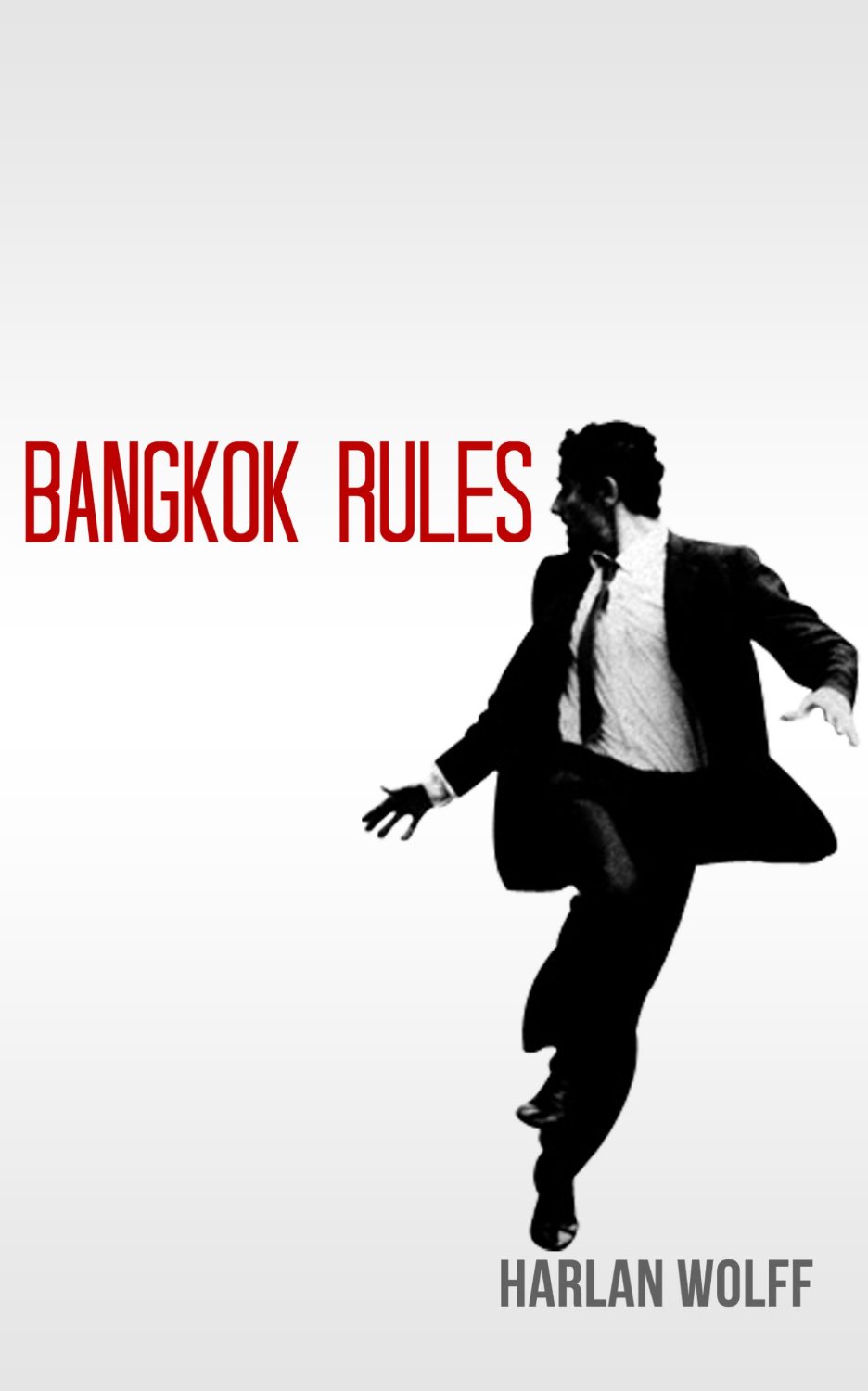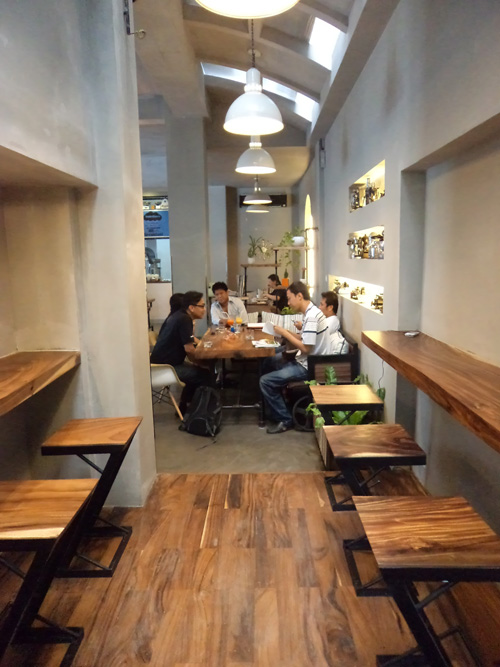With Hollywood’s remake of 2003 cult classic Old Boy, a grand prize for Pieta at the 2012 Venice International Film Festival and a wave of seasoned directors – Kim Jee-Woon, Park Chan-wook – hitting Tinsel Town, it’s time to take stock of Korea’s burgeoning film industry. More expressly, its deranged, crazy and crafted version of ‘twilight cinema’. Ladies and gentlemen, take a seat and buckle in: welcome to the weird and wonderful world of the Korean Noir Wave.
“Iron Man will look like… crumpled tinfoil. These movies will melt your face off.” – Grady Hendrix, New York Sun.
‘A man slowly presses his shirt in a non-descript apartment. He carries the hunched shoulders of a salaried everyman, except the ‘company’ he works for specialises in assassins for hire. Still, you can’t go to work without a well-ironed shirt…’ (A Company Man, 2012).
‘Dark night, falling snow, a car that won’t start. Inside a beautiful woman phones her fiancé to say she will be late, but not to worry, a repair van is on its way. A headlight appears and you just know that things are about to go bad…’ (I Saw The Devil, 2006).
‘Drugs, body harvesting, a Thai hit man, a furtive ex-secret agent. Greetings from the tangled world of The Man From Nowhere (2010).
Past – present: So where did all this come from?
In May 1980, the South Korean state brutally suppressed a student uprising in the city of Gwangju in the southern part of the country. Hundreds – perhaps thousands – were killed, with scores more arrested and imprisoned. This was the nadir moment of 30 years of authoritarian rule in South Korea.
Nowadays, where our images of the country are shaped by equine women and over-pampered ‘boys’ singing banal pop tunes, it is difficult to reconcile these events with our modern-day impressions of South Korea. Yet the country, for large parts of the 20th century, was anything but a K-pop video. A Japanese occupation, the Korean War and periods of instability and dictatorship occurred in spirit-numbing succession: South Korea was a nation that simply could not catch a break.
Authoritarian rule ended in 1987, but the experience and its scars, sustained by compulsory military service and the periodic sabre-rattling of its northern neighbour, have ensured a shadow persists over South Korean life. It’s hardly surprising, given all this, that those growing up in the 1980s and participating in the burgeoning democratic movement – the so-called ‘386 Generation’ – should give birth to a cinematic genre that blends melancholy and menace with the neo-lights of the ‘new Korea’.
So here, if any, lie the cultural roots of the Korean Noir Wave (KNW), a jarring counter-point to the Hellyu (‘Korean Wave’) phenomenon and the style, aesthetic and ‘Cool Asia’ image of contemporary South Korea. And while hardly the sum of the nation’s film industry, these potboilers have emerged as the most exciting and creditable side of Korean cinema.
Well made, intelligent and anchored in the darkest recesses of the Korean psyche, the films of the KNW underscore deep fault-lines running through the heart of Korean society, something that even three decades of impressive economic growth have been unable to hide.
What the rest of us get, meanwhile, is some of the most enthralling cinema around. In 2004 the judges of the Cannes International Film Festival agreed, awarding the KNW classic Old Boy the Grand Prix. With this recognition the KNW didn’t just arrive, it kicked down the door, swallowed your octopus and ran off with your sister.
Piqued your interest? Want to learn more?
Time for a little KNW 101, brought to you through the genre’s most impressive films:
Old Boy & Memories: Living with the past
Park Chan-Wook’s Old Boy (2003) tells the story of a man, Oh Dae-su, who finds himself locked in a hotel room with no clear idea of how he got there. When he finally emerges, 15 years later, he undertakes a quest to discover the motive behind – and perpetrators of – his long incarceration. This leads him on a journey of violence and revenge, played out against the backdrop of an unfolding relationship with a young attractive sushi chef.
Vengeance lies at the heart of Old Boy and it also drives two of Park’s other films, Sympathy for Mr Vengeance (2002) and Sympathy for Lady Vengeance (2006), Park’s famed ‘vengeance trilogy’. But it’s Old Boy, with its operatic intensity and choreographed madness underpinned by a warped commitment to love and devotion, which preserves its impact today. It’s interesting watching Hollywood’s efforts to reprise this ‘contained insanity’ in its own recent version of the film.
Memories of Murder (2003, Bong Joon-ho) mines a different landscape for its noir fare, yet like Old Boy what occurs on the surface is only half the story. Based on true events, at the centre of Bong’s picture are a series of grisly murders that occur in some unnamed part of rural Korea. Like the events that inspired the film, murdered women, dressed in red and bound and gagged with their underwear, are found in fields and ditches. A hardnosed old-school detective, Park Doo-man, heads the case, but he’s a creature more at ease with beating confessions out of suspects. His bosses decide a different approach is required and a forensic detective from Seoul is introduced.
Mismatched partners are no new plot line in noir film, but here it’s used as a tool to compare the old, brutish Korea – the world of Park and pre-democratic South Korea – and the ‘new Korea’ of the Seoul detective. To heighten the friction further, Bong declares his film set during the time of ‘military dictatorship’ in his opening credits – a device other KNW filmmakers, notably Lee Jung-beom in The Man From Nowhere, have replicated.
Watching Memories and Old Boy, you can see the directors using their storylines to exhume elements of Korea’s past and confront it head-on with the present. Further, they challenge you to consider what it means to be a person, more specifically a man, in the ‘new’ Korea, where decades of brutality and emotional suppression have shaped distinct notions of masculinity and identity.
In Old Boy, Oh Dae-su’s struggle and journey stand as a metaphor for efforts by the Korean nation to reconcile past wrongs and find some form of bruised contentment. In Memories, the ‘brutish’ behaviour of Bong’s rural detectives is mirrored against a representation of ‘modern’ Korea. The up-shot from both films – confusion, collision and outcomes that fail to satisfy anyone – suggests that any reconciliation remains fraught and distant.
A Bittersweet Life & A Company Man: Korean men are ’so’ complicated
Like all good noir, what distinguishes KNW from a thriller or action flick is the melodrama played out in the milieu of its protagonists. Such conflict, between inner emotions and external realities, drives two other standout films, A Bittersweet Life (2005) and A Company Man (2012).
A Bittersweet Life’s protagonist, Kim Sun-woo, is an enforcer for a Korean crime lord, obligated by loyalty to his master. In A Company Man, lead Hyeong-do is duty bound to The Director, a stern father figure who oversees ‘business’. In both films the directors draw on tensions between Korean notions of loyalty and personal inner emotions to propel their storylines. The consequences go far beyond personal melodrama, however: both films’ patriarchs unleash trains of violence that power the movies to their bloody climaxes.
Cultural theorists such as Frances Gateway (Seoul Searching, 2007) suggest this recurring plotline in KNW serves as a symbol of the challenge present-day Korean males face in balancing tradition, identity and agency. This in a society where military conscription and the virtues of hardship remain revered, while across it the energies released by new economic and cyber freedom continue to feed personal aspirations and emotions. That these should collide and give rise to conflict is no surprise: cinema offers a perfect stage for displaying such struggles. The fact it all ends so tragically, as it does in A Bittersweet Life and A Company Man, suggests there is no easy path to harmony.
I Saw The Devil & The Man From Nowhere: Revenge, anyone?
In I Saw The Devil, a detective played by Korean heartthrob Lee Byung-hun seeks to avenge the brutal murder of his pregnant wife. So far, so noir. Going further, the aggrieved fiancé seeks retribution – not by simply eliminating his nemesis, played by Old Boy’s Choi Min-sik, but through a slow process of psychological dismemberment, played out across a set of increasingly violent encounters. The resulting episodes, each one more visceral than the last, generate a steady feeling of unease until, before the end, you find yourself asking: ‘Who’s the real devil?’
Revenge and justice unfold more slowly in The Man From Nowhere. A pawn-shop owner with a furtive past is driven to extremes to save the life of a streetwise young girl. Not unlike the protagonists in Company Man and Bittersweet Life, the lead character, played by Won Bin, does his initial best to deny attachment to anyone. That he ultimately succumbs to his feelings and chooses to confront his past to save the child places The Man firmly in the KNW camp.
Criticised by some as a Leon knock-off, The Man rises above with the quality of its filmmaking and the sheer scale of its violence. The penultimate showdown – featuring knives, guns and an eyeball in a jar – is one of the greatest choreographed scenes of scripted violence in recent cinema. And while the likes of Tarantino have come to give the ‘Hollywood showdown’ a cartoon-like quality (think Django Unchained), the makers of The Man and I Saw The Devil are deadly serious (perhaps too much so?).
Both films also highlight another quality of KNW: the use of constraint to build tension. This ruse, repeated in A Company Man and I Saw The Devil, has the twin effect of adding a sense of inner strength to the protagonist, while making the moment they finally unleash even more compelling and powerful.
Yet violence and revenge remain complex beasts. For one, there’s a refusal to bow to Hollywood notions of justice and happy hereafters. Killers aren’t caught (Memories) or are able to commit their final crime (I Saw The Devil, The Chaser), while ‘heroes’, exposed by their acts of retribution, lose their valued unanimity or freedom (The Man, Perfect Number). What we’re left with is a muddy notion of revenge, where protagonists and those around them are left dead or scarred and we, as the audience, can identify neither a winner nor a feeling of satisfaction.
MISE-EN-SCENE:
The arrangement of actors and scenery on a stage for a theatrical production.
– Merriam-Webster Dictionary
Korean Noir Wave popularised a distinct mise-en-scène: the way films are made and crafted, covering everything from the performance and costuming of actors to the production values of lighting, sets and scene selection. Some of the defining features include lead characters in well-fitted black suits (Unjust, Bittersweet Life, New World) or, conversely, ill-fitting off-the-rack combinations (Memories of Murder, The Chaser); under-lit scenes (The Man); the stark contrasting of colours (I Saw The Devil), the attention-focusing use of silence (Perfect Number) and the choreographing of complex action sequences (New World, A Company Man).
But these examples and the phrases used to describe them – ‘stylistic embellishments’, ‘atmospheric’, ‘carefully measured’ – only provide a tantalising glimpse of the full KNW mise-en-scène. One of the best reproductions of the form in popular film is the fight at the House of Blue Leaves in the finale of Kill Bill. Here, the gently falling snow and the blue-tinged darkness add a Zen-like quality to the life and death drama played out between Uma Thurman’s The Bride and Lucy Liu’s Oh-Ren-ishii. This makes the eventual contrast of red/blood on white/snow all the more dramatic, while softening the reality of what has just occurred (Oh Ren-shii’s decapitation). This scene is pure KNW, mimicked perfectly by Park Hoon-jung in the opening scenes of I Saw The Devil.
CRiticism:
“Six camera moves in search of a meaning” – Richard Brody, The New Yorker
There are some clear issues at the heart of KNW. Female roles are often one-dimensional and underdeveloped, reduced to victims (Perfect Number, The Chaser, Memories of Murder) or the cause of the male lead’s inner turmoil (A Bittersweet Life, Scarlet Letter). Seldom are they valued for their own agency. One exception is Sympathy for Lady Vengeance, where the lead, played by Lee Young-ae, is the avenging force that drives the film’s story. Even here, however, critics have been quick to point out that Young-ae is essentially playing the victim, while her acts of revenge carry a masculine tone.
Such criticisms have merit, although the recent award-winning Pieta presents a dramatic redefinition of the female. In this mind-messing film, the lead – played by Jo Min-su – is used by director Kim Ki-duk to present an entirely different version of woman in KNW, with female agency at the heart of the story. Embracing imperfect scene angles, shaky camera holds and mundane scenes, props and costume, Pieta seems Hell-bent on turning the genre on its head. In doing so it addresses one of the other key criticisms of the KNW: that it places style above substance.
The argument that art takes precedence has several targets: plot, quality of narrative, character development (and sometimes the acting). Again there’s a degree of truth to these claims, but these are noir films, not documentaries or theatre. They are meant not to represent reality, but to offer a window for reconsidering the individuals’ role in Korean society, while exploring the darker sides – and implications – of human behaviour. They are also, undeniably, about entertainment. Visually arresting, visceral and psychologically insightful, their imperfections are outweighed by their strengths.
perspectives:
“Perspective! What is a ‘perspective’?” – Confessions of Murder
Song-Yi, seated in front of me in a Phnom Penh café, is a genuine piece of KNW history. “Yes, I was in Memories of Murder!” She laughs. “I was an extra; one of the children at the beginning of the film who chase after the tractor. They paid us in sweets. I think it was to get us excited and to make us run around more, but we did not run around enough, so they gave us more lollies [Laughs] then we run around too much! [Frowns] Crazy!”
Born in the early 1990s (a gentleman doesn’t ask for specifics), Song-Yi now works for a Korean manufacturing company in the Phnom Penh garment belt. Her age places her squarely after the 386 Generation, so what does she think about the KNW and its contribution to South Korean art and culture?
“It is not the same for us, living in Korea and seeing these films; our perspective is shaped by experience, yours by what you think the films mean. It is different.”
OK, but do you feel some of the angst and turmoil that the films portray? “Sure! But we are an Asian culture; we do not express these things openly. We use things like these films to express what we cannot say ourselves. What is interesting is how these films have not tried to embrace Hollywood; it is very Korean. I think this comes from the fact that our film industry can survive without the need for international audiences; our domestic market is strong, so like our K-pop industry we do not need to appeal to outside countries to survive commercially. If other people like, fine; if not, who cares?!”
Fine indeed, but can we draw any parallels between the KNW and the rise of the noir phenomenon in Cambodia? Beyond the fact noir expression in the Kingdom has remained literal rather than cinematic, there are some other key differences (Matt Dillon’s 2002 City of Ghosts is a notable exception). KNW remains almost wholly indigenous in terms of actors, plotlines and settings. Non-Korean characters rarely appear; certainly no one with a European complexion.
Cambodian noir, in comparison, draws heavily on the tensions and intrigue that arise when foreign ‘outsiders’ interact with the worlds of Cambodia and each other, the variant consequences providing sauce and momentum for their tales. Cambodian noir has still to find its own native voice and remains largely the preserve of expat writers. KNW, however, is a domestic phenomenon, with international directors yet to make any mark.
While KNW draws heavily on the glitz of rapidly evolving ‘neon Korea’ and its confrontation with the South Korea of the past, Cambodia’s noir is firmly entrenched in the grit of the streets, bars and scenes of modern Phnom Penh. All of which suggests the Kingdom’s evolving noir scene represents a distinct proposition from that of its East Asian cousin, driven by its own history and the nationality of the authors.
uneasy endings: so, what are we left with?
For an acolyte like myself, the KNW offers an artfully and (mostly) intelligent alternative to the increasingly dissatisfying world of Hollywood cinema. They also serve as a window into the world that is South Korea. Venturing beyond Hellyu, they encourage exploration of the struggles the country and its people face as they seek to attune with their nation’s past, changing normative expectations and their personal aspirations, under the neo-lights and geo-political realities of today.
Beyond Korea, at a personal level, KNW requires the viewer to reconsider the ideals of light and dark, good and evil, revenge and justice, while seeding an appreciation of deeper cinema that keeps us thinking long after the final scene.
exploring the world of knw:
In a world of over-hyped and rehashed Hollywood films, the KNW offers a parallel universe where even the most clichéd fare seems new and exciting. With near-on two decades of filmmaking to select from, you can cherry pick to satisfy your bent. Besides the movies already mentioned, here are some others you should track down:
• Bad Guy (2002)
• The Scarlet Letter (2004)
• The Chaser (2008)
• Mother (2009)
• Housemaid (2010)
• Helpless (2012)
DVD stores along Riverside yield up the better-known films (the Sympathy trilogy, A Bittersweet Life and The Chaser), otherwise it’s torrent time. Download blu-ray, MKV or MP4 versions to get the full mise-en-scène experience. And check your copy has the requisite subtitles – or be prepared to learn Korean. Enjoy!









